High-tech lighting installation by Simon Heijdens creates "3D drawings in water"
Design Miami 2013: designer Simon Heijdens has created a series of hand-blown glass vessels that turn data from wind movement into projected patterns of light, installed at Design Miami this week (+ slideshow + interview).
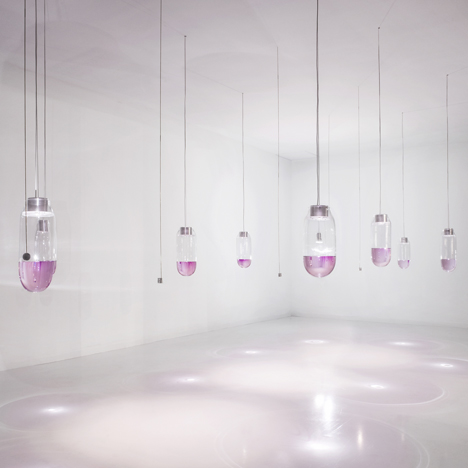
Heijdens’ Phare No.1-9 consists of nine suspended vessels that contain transparent liquid. A light source at the top of each vessel shines into the water and creates abstract patterns, which project onto the white walls and floor of the installation.
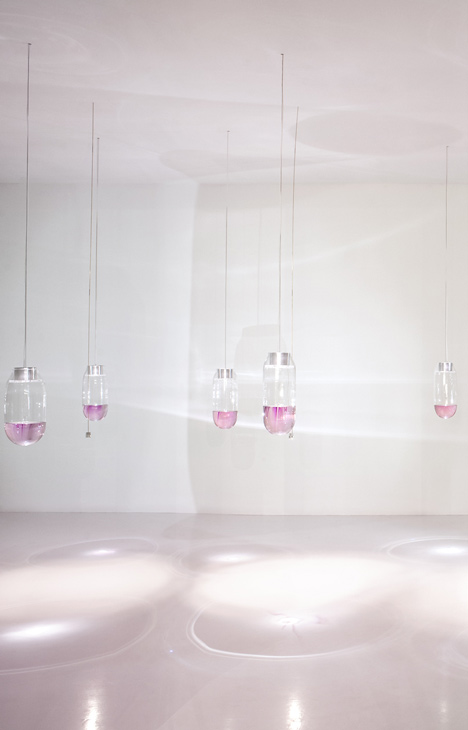
The project, commissioned by Champagne brand Perrier-Jouët and presented at Design Miami this week, is intended as a contemporary interpretation of the Art Nouveau movement.
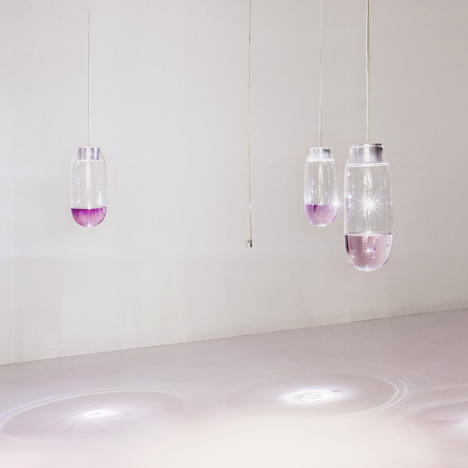
Art Nouveau, which flourished from the 1890s to the First World War, is known for its florid lines but Heidjens said that its artists exploited the latest technological developments.
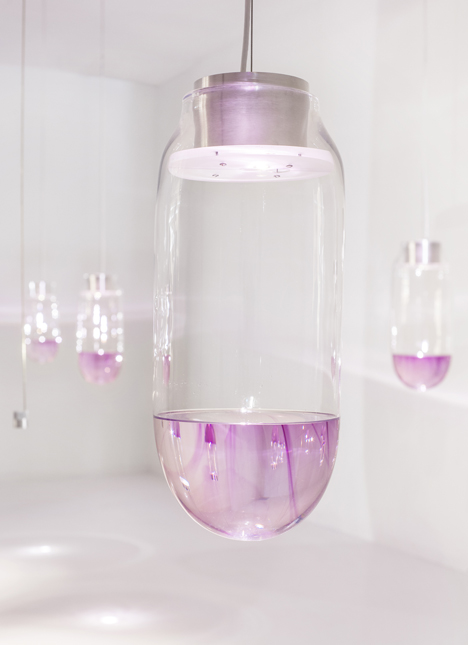
"They saw themselves as naturalists, making big lavish botanicals, as natural as possible," he said. "But looking further underneath that skin, there is a really strong geometry and mathematics to their formal language and to the way the technology of their time was used in their work."
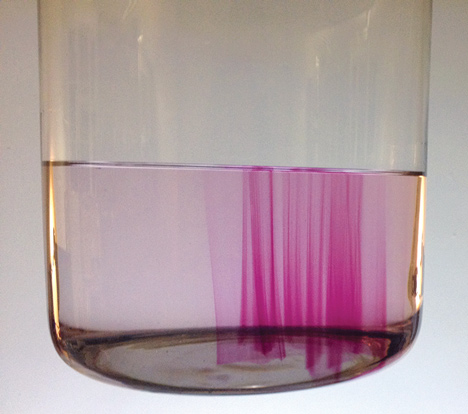
Phare, which means lighthouse or beacon, takes data from outdoor sensors that monitor the wind and transforms it into a narrow beam of light that shines into the liquid within the vessels. When the light hits a photo-sensitive dye within the liquid, it produces delicate three-dimensional "drawings" in the vessels.
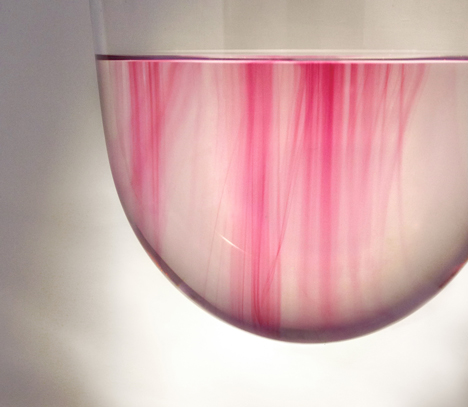
The dye gradually dissipates and becomes transparent again, changing the patterns that are projected around the room.
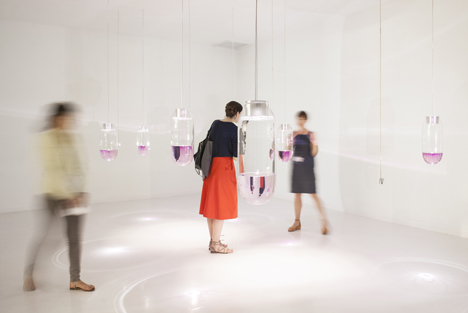
"It's activated from above electronically and the dye is activated downwards through the volume of the water," said Heijdens. "I find it interesting that you get a drawing between sculpture and graphic, because you can walk around it and see it from different angles. The dye is in flux and it dissolves in half a minute."
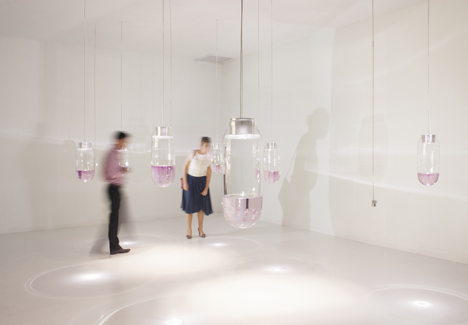
Heijdens was reluctant to talk about the technology behind the piece, saying: "The conversation about technology is not one I really want to have because I think it's not the interesting part of the project. I think the true value of people walking in here, without any baggage or any understanding, hindered by any kind of perception, is just the sudden wonder."
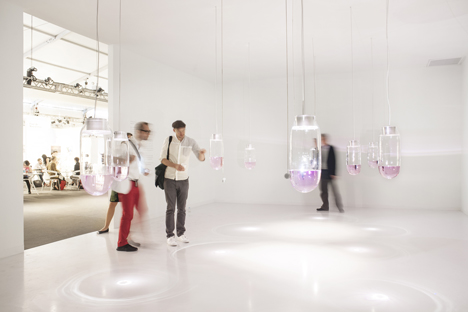
Here’s an interview with Heijdens conducted at Design Miami yesterday:
Marcus Fairs: Tell us a little bit about the project.
Simon Heijdens: So there are nine glass containers that are filled with water in which I developed a technology which enables me to make a drawing in water; a 3D drawing. The round bottom of the glass containers filled with water gives a lens effect and projects the drawing into the space.
All of the pieces were commissioned by Perrier-Jouët. I was asked to look into their heritage of Art Nouveau, which is very strong. It wasn't a movement that I've ever been particularly interested in but looking into Art Nouveau in a greater sense, and also how it's set in its time, it's kind of fascinating to see in the early 1900s there were massive things happening in industry, technology and the popularisation of the printed poster, photography, and the invention of cinema; basically the pillars of our concept in media.
I find it interesting in that case how technology is very strongly affecting what the artists and designers and architects of their time are doing. All the classic Art Nouveau posters, the specific type of colour area and vector lines are very defined by technology and I think that was the first connection I felt to my practice. My generation had the digital wave when I graduated, and suddenly there was this enormous amount of new materials and enormous, really sudden possibility to use the materials much more than 10 years before that.
I find it very interesting how that part of technology is affecting industry and I think that specifically for Art Nouveau, because looking at it objectively you see the very strong curve. They saw themselves as naturalists: big lavish botanicals, as natural as possible. But looking further underneath that skin, there is a really strong geometry and mathematics to their formal language and to the way the technology of their time was used in their work.
Marcus Fairs: How would you describe your work?
Simon Heijdens: My general practice is about countering the perpetual nature of architecture, the perpetual character of architecture that we live our lives in, increasingly in this perpetual manmade surrounding which is more and more designed to function day and night, with climate control and 24 hour lighting, also socially, designed to work with people across the world, the objects in space around us makes us more homogenous.
And also on a larger scale, how cities and high streets are designed more to look like each other and I suppose the general aim of my practice is to counter that and to use materials with a variable nature and a certain character and softness, to bring back the timelines of a certain space because when these spaces are soft enough to bury the imprints of their use, that gives you a much more sense of place.
Marcus Fairs: So tell me how it actually works. How do you draw in water with light?
Simon Heijdens: The dye inside the water has the ability to switch from being completely transparent to its reddish tint.
Marcus Fairs: So is it a photo-sensitive pigment?
Simon Heijdens: It's activated from above electronically and the dye is activated downwards through the volume of the water. I suppose, cutting a long story short, I find it interesting that you get a drawing between sculpture and graphic, because you can walk around it and see it from different angles. The dye is in flux and it dissolves in half a minute.
Marcus Fairs: What triggers the dye to become that colour?
Simon Heijdens: I don't think that's a conversation that I'm interested in. I think it's not the point, it's not because it's a secret but I think the true value of people walking in here, without any baggage or any understanding, hindered by any kind of perception, is just the sudden wonder. Like do you remember the first time you saw a Polaroid develop? I think the strongest thing I remember of that is the sheer magic and poetry of that. Therefore the conversation about technology is not one I really want to have because I think it's not the interesting part of the project. The important thing with technology is what you do with it.
Marcus Fairs: But how does it work?
Simon Heijdens: You've seen how it works. I find it really important to not make that the basis of this story and the piece.
Marcus Fairs: I want to know how it works.
Simon Heijdens: I told you.
Marcus Fairs: You're not going to tell me.
Simon Heijdens: We could have a three hour conversation about the science of wavelengths of light or we can speak about what you thought when you walked in there and what you felt like.
Marcus Fairs: Honestly, I want to know how it works. When I saw a Polaroid for the first time, I wanted to know how it worked. I think people will look at this and wonder how this works.
Simon Heijdens: I think in that nanosecond of seeing it and being really amazed and then starting to worry about how it works, even if it's just half a second, I think that's something to cherish, especially now because everything is explainable in life. Everything you walk up to you understand, you don't really ask any question about it.
Marcus Fairs: I believe the opposite. If someone says to me something's magical I'm like, bullshit, it's not magical. How does it work?
Simon Heijdens: I'm not saying it's magical, I'm interested in you seeing it or Mr A walking into it, without having read it or having a technological mindset from reading your article. I think its important to me that there is a carelessness about that.
Marcus Fairs: Okay. So it's some kind of photo-sensitive dye and the light triggers that change?
Simon Heijdens: Yeah.
Marcus Fairs: Did you see that thing that Troika did in Kortrijk last year? They had this old barn or something and they had these lights shining up from the floor and the light curved in an arc. There was this brief moment of magic, when you went, f*ck, how did they make light bend like that?
Simon Heijdens: And did you ask that?
Marcus Fairs: There was a sign on the wall that told you. It explained how it was done, using Fresnel lenses to refract the light to create an illusion of curving light. The light didn't really curve; that's impossible. So there was the wonder of first seeing it and then there was the explanation to satisfy your curiosity.
Simon Heijdens: Right, I think there's a structural difference, Troika are my best friends, but there's a structural difference between what they aim to do with their practice and what I do. The way you are going to put this [interview] up is going to define someone's expectations of the piece before seeing it.
Marcus Fairs: Yeah that's my job, sorry. That's what I do!
Simon Heijdens: Well the same for me. My job isn't a scientist. I'm not like, hey guys, you're going to see what I can do. I understand that you're providing the shortcut.
Marcus Fairs: Yeah but it's not a shortcut. This is bloody hard work! It's not an easy interview but it all started a couple of days ago when I first saw it I asked how it worked and I was told that nobody knew. So I've got a bee in my bonnet. I want to know.
Simon Heijdens: That's amazing though. Even if it's just three days of just you with a bee in your bonnet, that's an achievement on its own.
Marcus Fairs: Yeah, you got me interested.
PR person: Maybe it's interesting to talk about the wind and the movement and how that triggers the drawings.
Marcus Fairs: Yeah, what triggers the drawings? Magic, right?
Simon Heijdens: A little bit. I don't know if you know much about my work in general but like including fluctuating timelines from the exterior to reflect inside and to bring back a natural timeline. It's also here but perhaps in a less apparent way in my lights in the project in Chicago that you published. That was the only other thing that you published of mine, Marcus.
Marcus Fairs: And this is going to be the last at this rate! Also, it's sometimes very hard to publish this kind of work in a convincing way. The one in Chicago - the window thing - looked really good on screen. But often it requires video to get this kind of project across.
Simon Heijdens: You don't think this looks really good?
Marcus Fairs: Yes. That's why I'm here talking to you.
Simon Heijdens: Interesting though. The other project you published, you didn't come and ask me about it…
Marcus Fairs: I didn't write that story. But this is going to be the best interview of the week. So back to the project: what does it draw and why?
Simon Heijdens: The patterns of wind that are passing outside are defining the drawings that are moving from one container to the next. I'm kind of making not just individual elements but part of a larger space because this setting is not just a technology room. It's about how it makes that step from existing on a millimetre scale and becomes projected towards the space as a whole through the lens.
Below is the press text about the project from Perrier-Jouët:
Phare No.1-9, the new light work from designer Simon Heijdens, commissioned by Perrier-Jouët House of Champagne, was today unveiled at Design Miami. Heijdens’ immersive piece creates a captivating experience that reveals the poetry of the natural world through an avant-garde narrative. Heijdens’ work blends art, craft, design and new techniques seamlessly, resulting in an exciting re-interpretation of what Art Nouveau means to the 21st Century.
Phare No. 1–9 is nine hand-blown glass vessels, part filled with transparent liquid, suspended in a pure white room. Light emanates from each 'Phare', referencing its namesake: a lighthouse. In a reflection of Perrier-Jouët’s own material essence the work explores water as a dimensional volume, and it becomes a translucent refracting medium for light. A constantly evolving story grows within the water and is illuminated to fully immerse the space in pattern that moves from one Phare to the next. The totally white environment thus becomes both a screen and a narrative that one can walk inside, allowing the experience of the piece from different perspectives.
With Phare No.1-9 Heijdens has found a completely new way of drawing and building up images. Just as Art Nouveau saw Jules Chéret introduce the printed poster, and Louis Lumière create moving pictures, Heijdens presents a new medium of expression that echoes the period’s temperament of aesthetic innovation. His work explores the concept of coincidence, to trace and reveal the hidden essence of the spaces and objects that surround us in everyday life. Phare No.1-9 delves to the core of Art Nouveau and its principles of a studio-based, crafted art-piece, and merges the organic with avant-garde technology. The installation breaks boundaries of how we experience the natural world, and opens up the static character of our structured surroundings.
"I am interested in how we relate to objects and the space around us," says Heijdens, “I try to bring back a sense of nature and coincidence back into the homogeneity of the everyday. With Phare No. 1-9, I have worked with water for the first time, exploring its narrative qualities and variable character. It’s been a joy to interpret the brief from Perrier-Jouët, and I hope that with Phare No.1-9 I have captured a characteristic of water and light, revealing something that we couldn’t normally experience, in a totally new way."
"We believe Phare No.1-9 by Simon Heijdens truly takes the Art Nouveau ethos into the 21st Century, and creates a remarkable experience unlike any other. The craftsmanship and vision of Simon, combined with his unique take on expressing the natural world, has resulted in an astounding work." said Axelle de Buffévent, Style Director for Perrier-Jouët. “We are extremely proud to be part of Design Miami/ through this commission, and to have made a genuine contribution to the contemporary design world.”
This marks the second successive year that Perrier-Jouët has taken part in Design Miami/, both through commissioning original work, and as the exclusive champagne partner for the fair. The role as a patron for contemporary design began in 1902, when the champagne house worked with the significant French Art Nouveau artist Emile Gallé. He created the iconic anemone of its Belle Époque cuvée, still used today. Since then the house has commissioned many established and emerging designers as part of its continued artistic heritage.